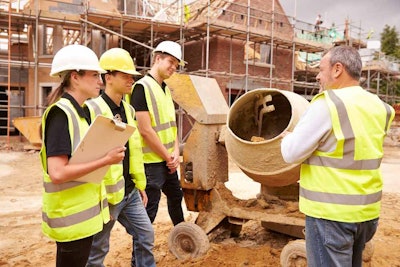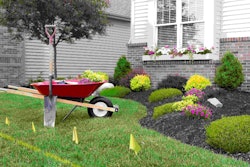
Led by the Occupational Safety and Health Administration (OSHA), the event runs Aug. 10-16. OSHA says that safe workplaces are sound businesses, and successful safety and health programs can proactively identify and manage workplace hazards before injuries or illnesses are caused, which improves sustainability and the bottom line.
Injuries on the jobsite are common in the green industry, but your landscaping company doesn’t have to be another statistic. Check out a few of the most common types of on-the-job safety concerns that affect landscapers and how you can combat them.
Common safety concerns for landscapers
There are many jobsite safety concerns landscapers can fall victim to, but some of the most common are lighting strikes, dehydration, sun exposure and hearing loss.
Lightning
Members of your crew might be skeptical when you mention the probability of being struck by lightning on the job, but it’s much more common than you might think.
Regardless of how severe the storm is, always exercise caution when working outside when thunder is heard. Whether or not rain is present, crew members can still be struck by lightning.
According to the National Weather Service, there are an estimated 25 million cloud-to-ground lightning flashes each year in the United States. Also, more than 1,000 people in the U.S. are struck by lightning. On average, around 50 people are killed and hundreds more suffer permanent neurological disabilities.
The old saying goes, “If thunder roars, go indoors,” and the National Weather Service recommends staying indoors for at least 30 minutes after hearing the last clap of thunder.
To find out more about how to respond during a storm, click here.
Dehydration
As someone who works outdoors all day, every day of the workweek, it can be tough to ensure you are taking in enough water to stay hydrated. The human body is made up of 60-70 percent water, making proper hydration imperative.
Seventy-five percent of people in the United States are chronically dehydrated, and many are unsure of how much water they need to drink in a day.
It’s recommended that an average man ingesting around 2,900 calories a day need to take in 12 8-ounce cups of water, which equals 96 ounces. For an average woman ingesting around 1,900 calories a day, it’s recommended that she drinks nine 8-ounce cups of water, which equals 72 ounces.
According to OSHA, drinking one cup of water every 20 minutes when working in an area 80 degrees or higher is recommended.
To find out more about electrolytes, fluids and understanding the heat, click here.
Sun exposure
As landscapers, it goes without saying that you’ll be in the blistering heat most workdays, and for those who don’t actively work to keep sunburn at bay, skin cancer is a reality.
Though it may seem harsh to ask crew members to wear long sleeve shirts and long pants while working in the bright sun, OSHA says this is crucial to protect workers from sun exposure.
Since ears are increasingly susceptible to sunburn, OSHA also recommends your crew trading in their baseball hats for broad-brimmed hats instead, even if sunscreen has already been applied to the area.
Be sure and check that your crew is using sunscreen, preferably a broad-spectrum SPF 30 type that can withstand UVA, UBA, and UVC rays, and it should also be able to absorb quickly and not affect a crew member’s ability to operate equipment.
The sunscreen should be reapplied every 80 minutes at minimum, and it should be able to withstand heavy perspiration or immersion in water.
Hearing loss
According to OSHA, hearing loss is the third most common chronic physical condition among adults, and 22 million workers are exposed to potentially damaging noises at work each year.
Due to the numerous pieces of equipment used in the green industry, hearing loss is a top safety concern, but it is preventable.
Repeated or long exposure to sounds at or above 85 decibels (dBA) can cause hearing loss, and the louder the sound is, the shorter amount of time it can take for inner ear hair cells to be damaged.
Not only can hearing loss cause major problems on the worksite, it can also cause workers to struggle in their personal lives.
To test whether or not worksite noises are at a dangerous level, see if you’re able to shout over the sound to be heard, if your ears are ringing after exposure, if the noise is painful to your ears or if you have muffled or decreased hearing long after exposure.
To find out more about permissible decibel exposure, click here.
Safety program
A proactive approach to safety is usually the best way of preventing accidents, and a good way to do that is to put into place a workplace safety program. These programs should include any training, procedure or policy that can help protect workers from a work-related illness or injury.
When creating this kind of program, there are numerous options, such as reaching out to safety professionals to talk to your employees or handing out a safety manual.
Don’t be afraid to include your employees in the creation of the program. By including them, they will feel more closely involved in the process and they will be able to give valuable insights during the development process.
There are four main objectives to focus on when creating your workplace safety program. The first is to make sure the company and those in charge are committed to the program and will place safety as a top priority.
The second is to identify and document any hazards or potential hazards currently present in the workplace. After they are identified, it’s important to eliminate the hazard, train employees to be aware of it and protect employees against said hazard by prescribing PPE.
The final step is to provide on-going training for employees to ensure they are able to handle hazards effectively when faced with them.
For a more in-depth look at creating a workplace safety program, click here.











